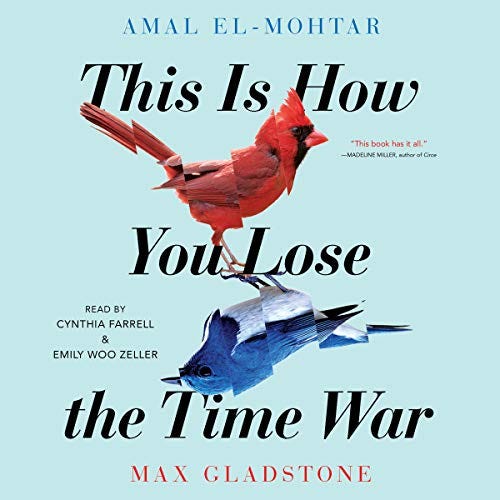This Is How You Lose the Time War is a fascinating science fiction novella built around the idea that two warring powers are traveling through “braids” of space and time to destroy or nurture various timelines. The warriors we get to know, Red and Blue, are on opposing sides. It’s not clear to us how exactly the various actions of our two soldiers impact either war effort; we only know that the overall objective is to completely destroy the other side. What we do find out is that one side is a mechanized world, while the other nature-based. As the work continues, the war seems increasingly futile. They’ve been fighting for long enough that their actions feel routine, almost rote, but when they begin interacting via secret letters, the love that grows between them kicks off a series of events that will change the war itself.
What surprised me about Time War is that it took me a minute to feel everything, perhaps because it’s short and moves quickly. I thought I would cry at certain points, but I didn’t. However, now that I’ve finished the book, I find that I can’t get this story out of my head. My heart aches for these two and everything they go through. I definitely want to reread it.
This novella won all kinds of awards when it was released in 2019, but I didn’t come across it until 2023. It strikes me that this reflects my own experience with the work, because it took some time for me to connect with it. According to Wikipedia (don’t read the entry—it gives away the entire plot in one paragraph), a tweet went viral, and the novella rocketed to the top of best seller lists. I now have a goal for this Substack! Modest, right? At any rate, it’s an epistolary work, with one author writing Red’s letters and the other Blue’s. This is extremely difficult to pull off, so all those awards become all the more impressive.
The beauty of a novella, and what makes it so challenging to write, is that to achieve its concision and brevity, the authors must decide what we absolutely need to know and include no more. We need only know that this relationship is nearly impossible but thrives anyway. This is where the thrill and the heartache lies. We never learn the technology or magic that allows letters to live inside objects; they just do. I don’t want to ruin the surprise of the more creative ways they exchange letters, but I will say that my favorite letter is written inside sumac seeds (not the poisoned kind) and can be read only when the seeds are eaten. It’s such an intimate experience to share a favorite food, and the letters inside the seeds reflect that same visceral tenderness.
In a world that could alienate a reader, the authors include small details that draw us back in. Although the protagonists jump between many timelines, we can still relate to them when they occupy humanoid forms in familiar settings. I love a scene set in a nineteenth century London teahouse, for example. We do get hints as to what the characters’ true forms are like, which matters because they seem to be opposites. However, these are only included if sharing them offers a glimpse into the against-all-odds intimacy between Red and Blue. As the novella progresses, we sometimes have no idea when or where they are, but we remain grounded in that relationship. The framing story or setting around the contents of a letter can be strange, but this always offers a contrast to the love story itself. This highlights that main plot, which is the only thing that matters.
Falling in love is the same, no matter who you are, but it’s always also an entirely unique experience. It’s clear from the very beginning that love is where we’re headed. From the contents of the letters to their delivery mechanisms, a deep connection gradually blooms. There’s a progression from objects meant to be read and then destroyed to literally consuming the other’s words. I’m always so impressed when science fiction involving such disparate experiences manages to penetrate to my heart.
I found great beauty in the epistolary format, in this case, because the language reflects the progression of the love story, which in turn allows us to relate to that story. Most of us feel pulled towards something that seems dangerous at one point in our lives, which is how the story begins. (There’s an entire genre of books called “enemies to lovers.”) We see the development of the relationship between Red and Blue begin with wary, hesitant interactions, a kind of circling around each other, in the guardedness of the language. Eventually, they discover that they have more in common than not, and they bare their souls with extravagant metaphors and similes.
In this case, I don’t recommend the audiobook—I will read it again in the text version. There are two narrators, but their voices aren’t different enough. This becomes confusing at times. I would rather have had one narrator adopting two different voices, because I think the change would have been more apparent.
Obviously, I do recommend this beautiful little novella.
.png)



